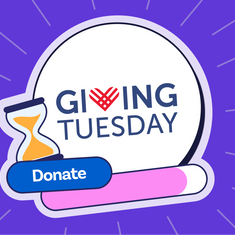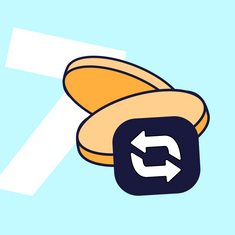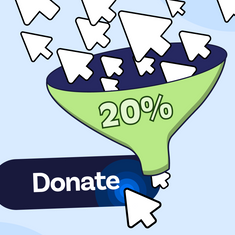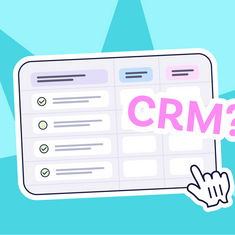
How to guide on why recurring giving programs are important and how to develop one | Nurturing long-term supporters to reach your fundraising goals faster
It’s no secret that donors are the bee's knees. And we are seriously grateful for every dollar they donate.
Let’s face it, though: if you could choose regular giving over a one-time, you’d choose the first every time.
And by regular giving,’ you mean..?
It’s when donors give a set amount every month! Also called sustaining, recurring, and regular. But regardless of name, it's a sweet little morsel of the fundraising pie.
That’s because regular giving programs:
💰 Provide a steady, predictable stream of income
🖇 Bolster engagement and connection with donors
📈 Increase donor retention which means a higher lifetime value!
📈 Account for an average of 19% of the online fundraising revenue (and only 10% for small charities)
And here’s why:
Money talks
Our data nerds ran the numbers on Raisely, discovering that:
- $20 is the most common monthly donation
- $30 is the average monthly donation
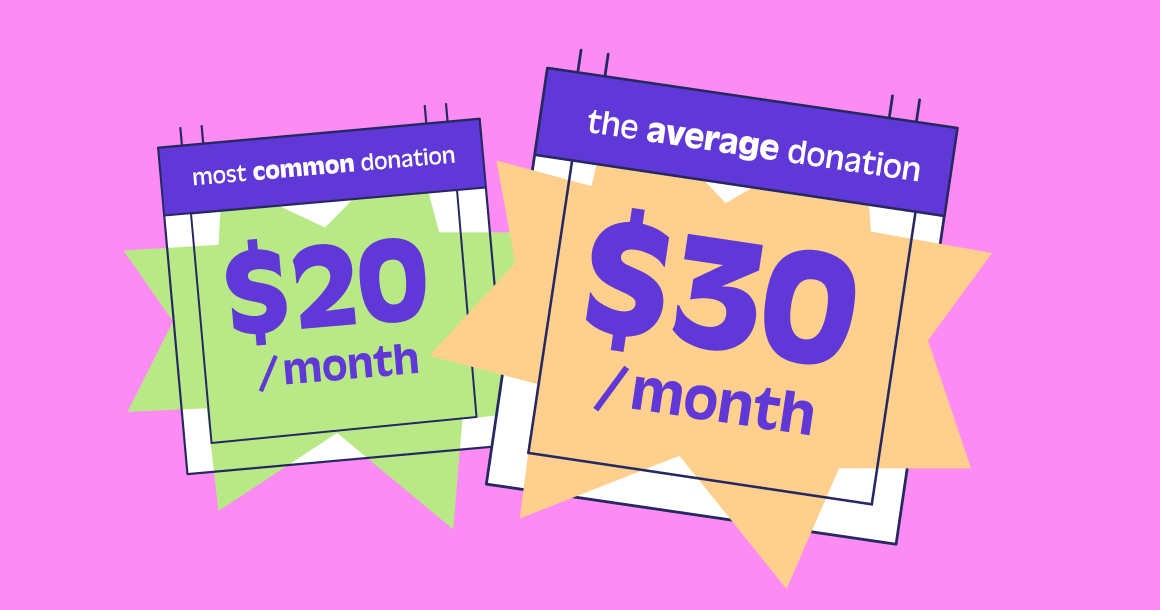
So you can see why charities work their bottoms off to execute effective regular giving campaigns.
A $50 one-time contribution is awesome - but what if you could persuade a donor to commit to $30 every month?
Think about how many one-time donors you have. Swaying even a handful of them to move to a monthly giving program will see you tap into a reliable, ongoing source of fundraising.
The flipside
Ok, yes: it can be a bit of a slog to get there. But we reckon it’s worth the grind.
That’s why we ran a webinar on this very topic in January.
It was hosted by Raisely’s US Growth Lead, Chas Offutt, a seasoned fundraising leader.
He then passed the mic to Greater Good Strategy’s power duo: Emily Goodstein, Founder + CEO, and Francoise Stovall, Senior Strategist.
You may have attended the webinar (yay!). If not (or even if you did), we think it’s a whole lot quicker when someone else pulls the best bits into one fact-packed, easy-to-follow guide.
So that’s exactly what we’ve done!
You’ll also find a case study from Raisely charity, The Small Things, to see how all this works day-to-day in a real-life organisation.
Josh Lowry, Donor and Sponsorship Coordinator at the nonprofit, knows all about regular giving, why it’s worth investing in, and how you can tackle it.
But before that...
Here’s a bit of context with a quick overview of how donors are giving across the globe.
What monthly giving looks like worldwide.
For starters, humankind is doing a damn good job of donating.
🇺🇸 In the US 🇺🇸
- Nearly half of Gen x-ers (around 20% of the population) are signed up for monthly giving programs.
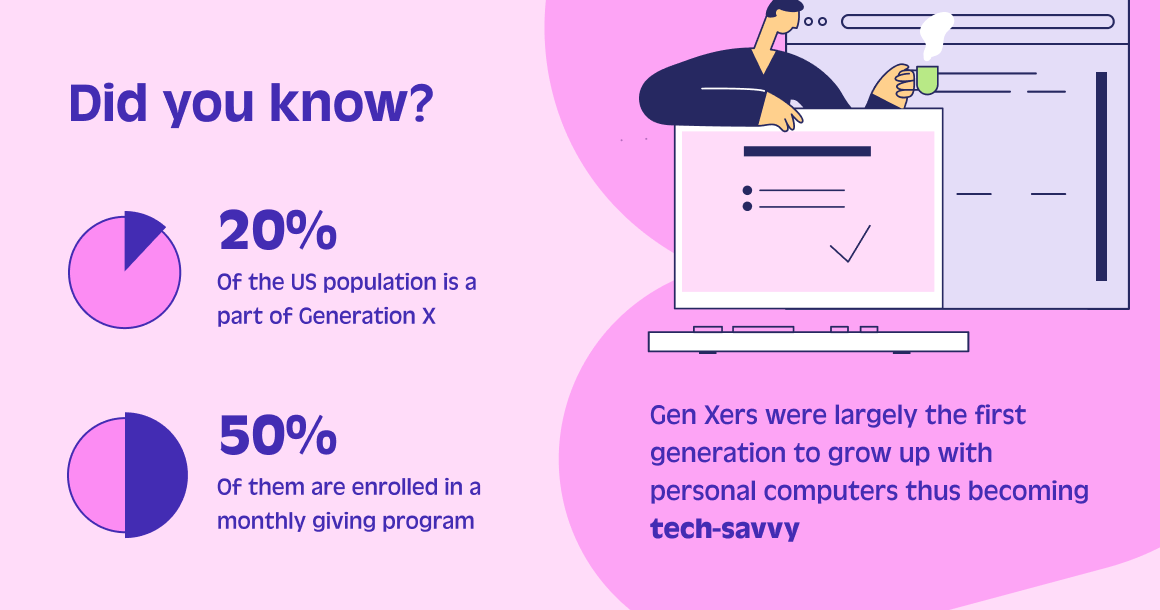
🇦🇺 In Australia and New Zealand 🇳🇿
- More than 60% of donations are now done through mobile
- An average donation amount sits at $50 (and has for the last three years)
- Giving activity spikes in the evening and is primarily done around the middle of the week for both peer-to-peer and appeal fundraising (Monday and Tuesday are warm-up days).
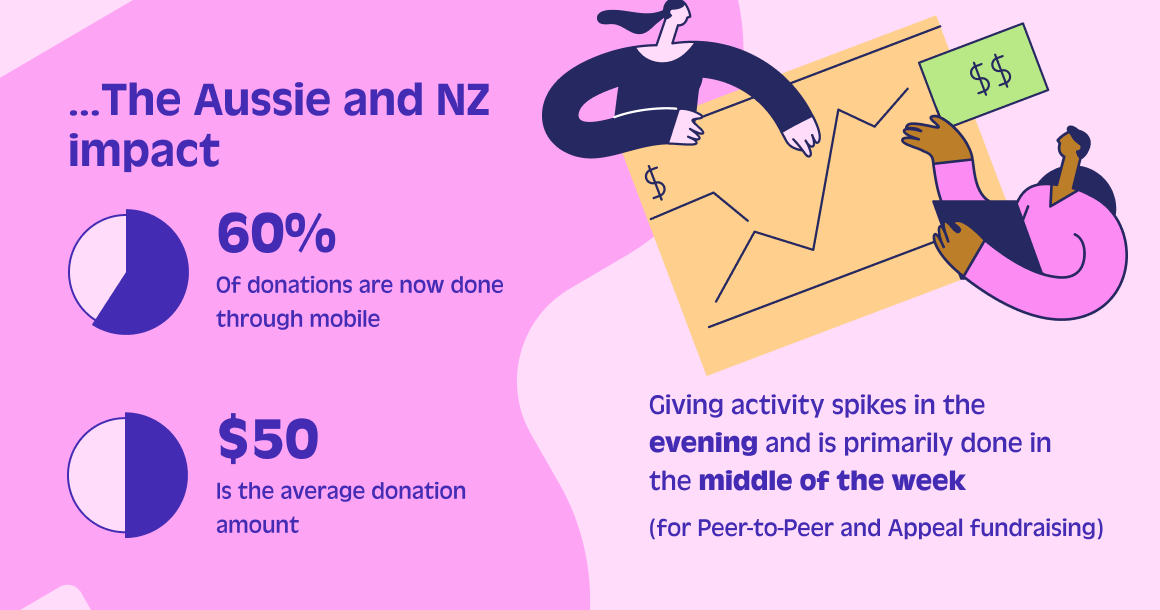
What does all this tell us?
Basically, it’s some great guidance on how to plan, develop and execute your monthly giving program.
Think about your organisation, audience, and potential donors.
Specifically:
- How do your donors like to give?
- When do your donors give?
- What are they giving on average?
- Where are the opportunities to encourage them to contribute more?
- Why do they want to give to your organisation?
Then design (or modify where needed) your programs to fit.
Alright, that’s enough of the numbers.
Get your teeth into our guide below. And enjoy!
Regular giving best practices
1. Start with your loyalists
Drill down into your data and see who's primed, polished, and ready to be a regular donor.
By that, we mean donors who've given more than once in the past year. You’ll probably discover some of these people are giving 5-10 times a year - they’re quasi regular givers, anyway!
Then think about how to approach them and what your message will look like.
Did you know, approximately 96% of Americans have a mobile phone, and 81% have smartphones? While there are pros and cons, texts have an open rate of 98% versus a 22% rate for emails. Text messaging holds a ton of potential for nonprofits.
Whether it’s an email, phone call, text or direct mailer, make it personalised, thoughtful, and friendly.
Think about who your donors are and the best channel for them.
Your budget may dictate this to some degree, but keep your donors in mind regardless of your strategy and style.
2. Two buttons are better than one
Use every opportunity to ask for more.
No matter what info you’re sending donors, always ensure there’s a ‘donate monthly’ button in the email.
Oh, and when they click on that button? It should go to a page that’s default is set up as monthly.
They don’t want to rummage around your website (and you don’t want to risk losing them at the last minute).
Tip: On your fundraising page, always include a donate button both above and below the fold. If you have space make that two donation forms so there is another opportunity to convert.
3. Sweeten donors up with a swag campaign
What on earth is a swag campaign?
A swag campaign is about recognising and rewarding donors with a gift (i.e., some loot, essentially, or 'swag'), and building long-lasting relationships.
Or, as Chas likes to say: "gratitude with an attitude."
Now that’s an attitude we can love!
Got any inspo?
Ok, so depending on your donors, you could use merchandise like:
☕️ Coffee mugs
👜 Tote bags
🧢 Clothing
Here are some fun examples from Liptember.
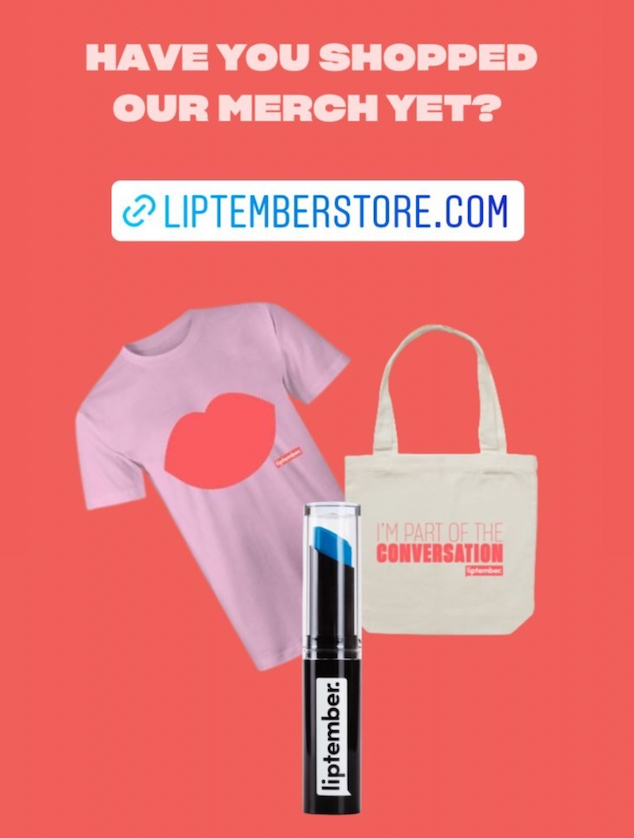
Whatever you choose, make it a limited edition, so they feel super special. And mission-based swag are the bomb!
Not keen on gifting more ‘stuff’? You don’t have to.
You could go for more of an experience like...
💻 A regular webinar with your CEO👀 A tour of your organisation (as above!)
👀 A tour of your organisation (as above!)
Use all your comms channels - social media, email, and website - and make it pop with some va-va-voom visuals.
Be as imaginative as you dare!
4. Thank you, thank you, thank you
Do you feel slightly miffed when someone doesn’t thank you? (Drivers who don’t acknowledge me letting them into a lane: I’m talking to you 🤬)
Your donors are the same.
Of course, they want to feel appreciated!
So when you win them over, you’ve got to shower them with appreciation
So get out your notepaper and start penning some thank yous.
Yes, Millennials, we literally mean a handwritten letter (we can hear the groans from here).
If this idea is genuinely distressing for you, stick to email. Ask your board members to send a one-off, personal email to newly-acquired monthly donors.
Or, try these ideas:
- A quick email or phone call to acknowledge the anniversary of a donor’s sign up day.
- Let donors know the direct impact of their regular contribution to your organisation (e.g more effective budgeting, allowing you to scale up operations and be more financially responsible).
5. Speak to donors
Regular donors make a serious commitment to your organisation. Your organisation owes them the same respect.
People want to feel like they’re part of something big. That they’re genuinely involved in the organisation.
As a regular donor, they’re not just investing in your nonprofit. They’re telling you they want to be part of it on a fundamental level.
So, give them a voice and truly listen to their feedback as they are part of your movement.
How, pray tell?
Regular (2-4 times per year) surveys asking their opinion on... well, anything, really.
What swag floats your boat? Does this sticker make you want to donate? How has your donation experience been?
Of course, the important thing is what you do with their feedback.
Is it something you can incorporate into your next campaign?
Do these ideas need more discussion?
Are we treating our donors right?
Were Ross and Rachel actually on a break?
Food for thought: Response rates to surveys can range from 15 to 50 %. Increase response rates by sending the survey out multiple times, just make sure to leave enough breathing room in between sends. You could also reward those dutiful donors with a gift. They've taken the time to share their feedback, show them your gratitude!
6. Get across segmentation
You’ll have all sorts of donors in your books - some giving hefty amounts infrequently; others a smaller donation more often.
So, it’s a good idea to segment your donors.
That gives you a clear idea of who’s in your database, how much they’ve donated in the past and what they need from you to potentially move to monthly giving.
And look closely at your giving history.
It’s the more monthly giving crew you want to focus on here. They’ve demonstrated a long-term commitment to your organisation and are likely ripe for the picking.
Conversely, you probably won’t yield much fruit from the person who’s been more patchy with their donations.
Once you’ve found the most likely contenders, get in touch with them.
7. Gift strings made to order
Thanks to your segmentation work, you’ll understand what a realistic ask string* or dollar amount will be for those donors. *That’s a list of suggested dollar amounts donors can choose from.
So, if you’ve got a donor who has never donated more than $15 in one go, they probably don’t have the appetite for $150.
Equally, you'll have people who won't budge from the $100 mark. And you don't want to miss an opportunity of a larger contribution by pegging your numbers too low.
It’s about knowing your community, acting on that information, and making it personal.
Here is an overview of the average monthly giving amount in the nonprofit sector:
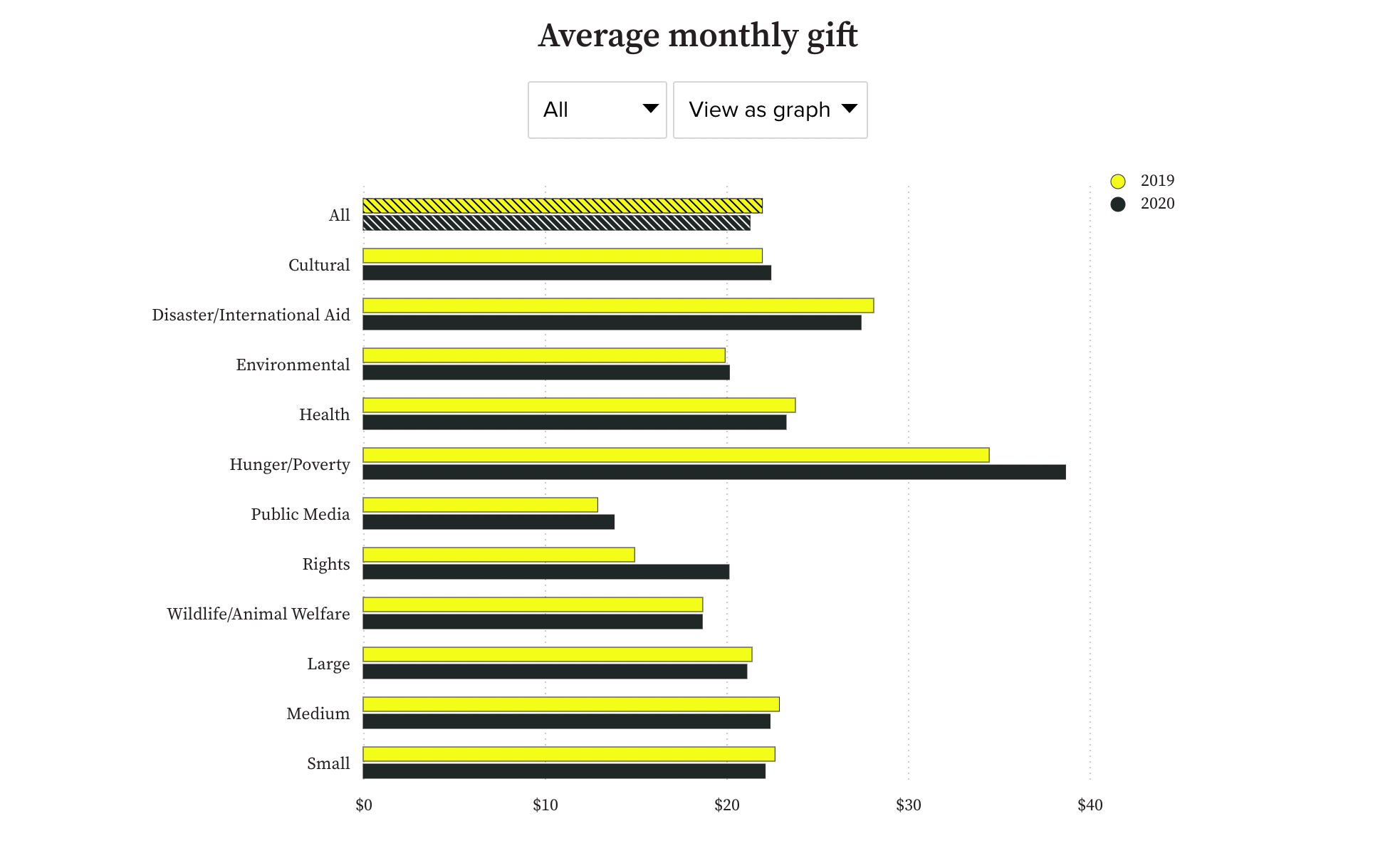
8. Optimise the experience
A good user experience leads to better fundraising outcomes.
And a big part of making users happy today is increasing your mobile conversion rate (remember more than 65% of donations are now done through mobile).
It makes sense then, that Apple Pay and Google Pay are becoming the preferred ways of paying for many people. And we know that Raisely customers with Digital Wallets on their websites can increase their mobile conversion rates by up to 60%.
Not too shabby!
The great thing about creating those through Raisely is that the page builder optimises for tablet and mobile. And you can use View-Specific Content options to see exactly how your website will look on different devices.
Easy for you, even easier for your donors.
9. Embed SMART forms
This isn’t new in the fundraising world. But it is uber important.
It’s about making a fundraising ask super intentional - strategically placing it on various pages and sections on your website.
Making it as easy as possible for donors to do their thing.
If potential donors can't get it sorted straight away, they'll lose interest. Leaving you without a contribution someone was poised to make.
You might, for example, embed either your donation form or contextualise the ask on the sidebar of your internal web pages.
Or, if your landing page directs donors to the About page, you could have an embedded box front and centre.

And you don’t have to stop at one or two (in fact, please don’t!).
It’s about giving every visitor to your website (socials too!) the best chance possible to donate. Especially when they've probably already decided to contribute.
Almost there
That brings us to the end of the guide.
But do stick around for some interesting insights into one of our fave customers, The Small Things 👇🏼
Case study: The Small Things
A lesson in how to establish a recurring giving program and nurture long-term supporters.
The Small Things is a charity working to improve the lives of children living in poverty. Through their sponsorship program, they are:
- Keeping kids at home, where they belong
- Providing last resort care for children in their residential care village
- Supporting children's education
Take it from Josh Lowry, the organisation’s Donor and Sponsorship Coordinator - converting one-off supporters into regular donors is worth the blood, sweat, and tears.
“You put a lot of effort into an end-of-year campaign. If you’ve connected with someone to the point where they’ve decided to donate, you’ve done most of the hard work. Don’t waste it!”
Josh Lowry, Donor and Sponsorship Coordinator, The Small Things
Yes. It’s safe to say the team at The Small Things places a lot of emphasis on encouraging donors to become regular givers.
So much so, that they offer a one-year free sponsorship to anyone who’s given more than $180 in a single donation.
Yes, it’s a leap of faith. It's a cost to your organisation, and there's absolutely no guarantee donors will keep giving once they’re asked to actually sign up.
Yet, time and time again, the risk pays off. The vast majority of donors take up the free sponsorship.
In turn, most crack on with a regular donation once their freebie year is up.
Why is it such a successful strategy? Josh points to these things...
Showing them the money (and its impact)
People love knowing how their donations make a difference.
So, make sure you send regular updates throughout the year.
A mix of formal (a letter from the CEO, for example) and informal (like extra content or personalised videos on Facebook) works well.
It creates a connection for the donor - both to the organisation and (in the case of The Small Things) their sponsored child/children.
Save the surprises for another day
Your donors deserve to have all the latest intel - before the general public.
Perhaps the program they're involved with is changing. Or their sponsorship focus is shifting.
Whatever the case, show them the respect they deserve.
Want to know what happens when you don’t show donors the love?
They can get seriously annoyed.
In fact, Josh remembers a very unhappy donor from earlier in his career.
While working in this former role, Josh witnessed as this donor discover they were still supporting a child - who was, in fact, no longer in the charity's care.
For the child, it was a good news story - they had been reunited with their family.
However, no one had thought to tell the donor. And yet, the child’s success story had been shared all over social media.
That was when the donor called it quits and stopped their sponsorship.
Which left a donor feeling unappreciated. And a charity minus a donor.
Eek.
That’s one doozy of a lesson learned.
Give them a voice
Like we said in the guide, you gotta keep your heroes happy.
And nothing says “we’re so grateful” like actually listening (and acting on) feedback from donors.
Wherever possible, open up the channels for two-way communication. It’s about making them feel involved, valued and part of something bigger than themselves.
So you’ve converted your one-off donor into a regular giver. What’s next?
Let’s just say it’s not about reeling them in and then leaving them uselessly flapping around.
Nope.
There’s slightly more to it, yah. But rest assured: it’s entirely doable.
Keep up the comms!
We can’t say it enough - do not leave your donors hanging. Keep. In. Touch.
Case in point: Josh says he’ll drop a donor a line if their sponsorship child has a birthday coming up. The team also makes sure donors receive regular updates on their sponsor child’s progress at school. Things like photos, drawings, letters are all sent to donors - who also have access to a closed Facebook group.
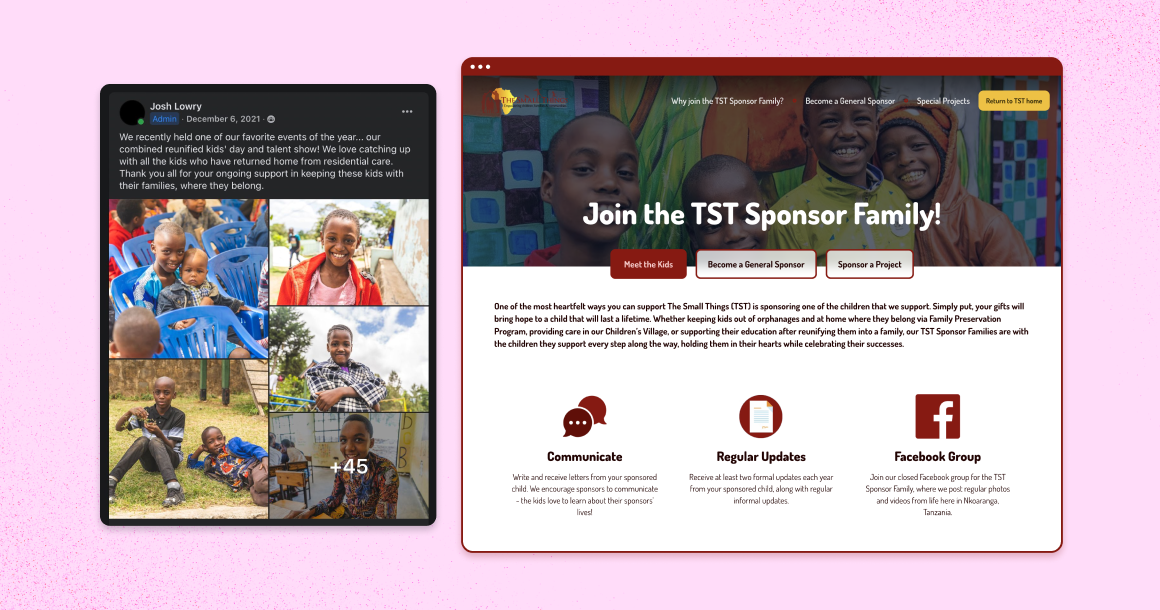
And often, it’s the trigger that donors need to request they increase their donation amount.
Bottom line: it’s the right thing to do. But it also pays off.
Remember your donors of old
Donors do drop off databases. It comes with the territory.
Josh is quite the re-engagement expert, though. And he reckons it’s worth reaching out.
Because the results might surprise you.
Around 18-20% of lapsed donors not only respond to an email but want to re-engage.
How good is that?
“It’s much easier to engage a lapsed donor than find a new one.”
Josh Lowry
Thank them!
See? It really is a thing in the NFP space.
Josh is also a fan of handwritten penmanship - though he does have a handy hint.
He recommends Thankster - a service that sends handwritten cards for you. They’ll write and post them for $3 a pop.
Tempting.
And, of course, make each card personal. Don't send the same generic message to all and sundry - tailor each note to each supporter.
As we mentioned earlier: if you’re seriously low on time and resources, an email is a thousand times better than nothing at all.
Just make sure your email lists are clean, updated, and segmented into sub-groups (so you can deliver more targeted messages).
Get rolling with a regular giving program
Phew. That was a biggie.
Wanna hear our two cents’ worth?
Bookmark the guide, start brainstorming, and develop a regular giving program of your own (you don't even need to handwrite it, either).
Oh, and if this guide was helpful to you, please share with a friend 🙏
Need a helping hand to get you started?
Raisely is ready to help you grow your regular donor program!
Ready to create your
next campaign?

Elissa is a Sydney-based copywriter, working as a word nerd/writer for Pencil + Crown. She loves stepping into a client’s world and crafting creative copy to tell their stories.

